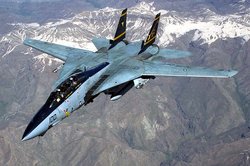Swing-wing
|
|
A swing-wing is a type of pivoted wing planform that takes advantage of the aerodynamics of a swept wing at high speeds while avoiding the drawbacks of such a design at lower speeds. It is successful in this respect, but the added mass and complexity required are currently believed to outweigh any advantages. The term variable-geometry is often used synonymously with swing-wing, though strictly speaking swing-wing is a specific type of variable geometry.
Missing image Wing.tomcat.vapour.arp.750pix.jpg F-14 Tomcat with wings swept |
Swing-wing aircraft developed from earlier experimental aircraft that were built to study the effects of a simple swept wing. The first of these was the Messerschmitt P.1101 whose sweep angle could be changed on the ground. A number of test flights were carried out at various angles to determine the tradeoffs.
At the end of World War II the P.1101 was taken to the United States for further study at Bell Aircraft, where versions were built that could vary their wing angle in flight. One problem discovered while testing the Bell X-5 was that as the wing pivoted rearward, the center of lift also moved to the rear, pushing the nose down. A system to compensate for this basic effect had to be added for any such design to be viable.
The swing-wing is most useful for those aircraft that fly at a wide range of speeds, and for this reason it has been used primarily in military aircraft.
A swing-wing was tried on the Grumman F10F Jaguar in 1952, but the F10F proved a failure and aroused no serious interest in variable sweep by the US Navy. The idea was again revived in the early 1960s as a way to reconcile ever-growing aircraft weights (and thus wing loading) with the need to provide reasonable takeoff and landing performance. The United States adopted this configuration for the TFX (Tactical Fighter Experimental) program, which emerged as the General Dynamics F-111, the first production swing-wing aircraft.
Similar requirements in the Soviet Union also led TsAGI, the Soviet aerodynamics bureau, to explore the possibilities of variable geometry. TsAGI evolved two distinct planforms, differing mainly in the distance (expressed as a percentage of total wingspan) between the wing pivots. A wider spacing not only reduced the negative aerodynamic effects of changing wing sweep, but also provided a larger fixed wing section which could be used for landing gear or stores pylons. This could, in fact, be adapted to more-or-less existing airframes, which the Soviets soon did, with the Sukhoi Su-17 (based on the earlier swept wing Sukhoi Su-7) and the Tupolev Tu-22M (based on the Tupolev Tu-22). The limitation of the wide spacing, however, was that it reduced the benefits of variable geometry as much as it reduced their technical difficulties. For the new, "clean-sheet" Soviet designs, TsAGI devised a more narrowly spaced arrangement similar to that of the F-111. This design was used (albeit at different scales) for the MiG-23 fighter and the Sukhoi Su-24 interdictor, which flew in prototype form at the end of the 1960s, entering service in the early 1970s.
A European consortium, meanwhile, adopted variable geometry for the Multi-Role Combat Aircraft (MRCA) project that emerged as the Panavia Tornado. This was an interdictor and stand-off interceptor similar in function to the F-111, albeit on a smaller scale. Meanwhile, the U.S. Navy arranged to replace the disastrous, abortive F-111B fleet interceptor with the Grumman F-14 Tomcat, the first real attempt to use variable geometry to create a really maneuverable air-combat fighter. Although somewhat handicapped by its considerable size and weight, the F-14 was remarkably agile, far more so than the F-111, the Tornado, or any of the Soviet swing-wing aircraft--lower effective wing loading (thanks to a 'pancake' fuselage that provided additional lift) and an automatic wing sweep control made a significant difference. Rockwell, meanwhile, adopted variable geometry for the Advanced Manned Strategic Bomber (AMSA) program that produced the B-1 Lancer bomber, intended to provide an optimum combination of high-speed cruising efficiency and fast, supersonic penetration speeds at extremely low level. The last swing-wing military aircraft to date was the Soviet Tupolev Tu-160 'Blackjack,' which first flew in 1980.
A swing-wing was also used by Boeing's entry in the FAA's study for a supersonic transport, the 2707. However during the design stage it became clear that the mechanism was so large that it would leave almost no room in the cabin for seats. The design was later abandoned in favor of a more "classic" delta wing.
While variable geometry provides many advantages, particularly in takeoff distance, load-carrying ability, and the fast, low-level penetration role, swing wings impose a considerable penalty in weight and complexity. The advent of relaxed stability flight control systems in the 1970s helped to even the score for the fixed wing, and no new swing-wing aircraft have been built since the Tu-160.

